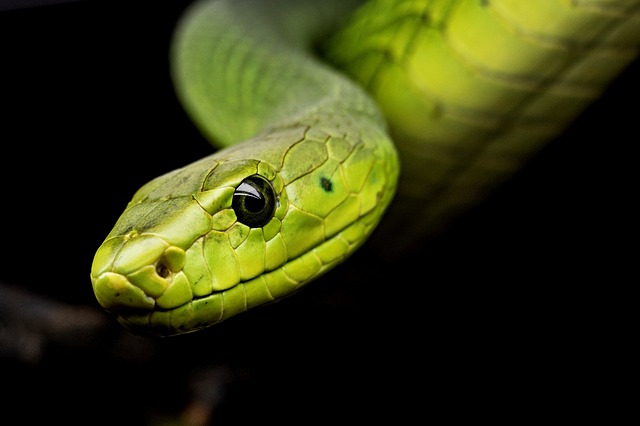Imagine a snake, slithering through the verdant canopy of a tropical forest, its long, sinuous body adorned with emerald scales and a belly tinged with vibrant orange. This is the Ahaetulla longirostris, or the Long-Snouted Vine Snake, a recently discovered species that has captivated the world of herpetology. Its discovery in India, hundreds of kilometres apart in Bihar and Meghalaya, has ignited a wave of excitement among scientists and nature enthusiasts alike.
The tale of its discovery is a testament to the serendipitous nature of scientific exploration. In 2021, two researchers, Sourabh Verma and Soham Pattekar, were on a routine expedition in Bihar, India, when their eyes fell upon an unusual sight – a lifeless snake, its body stretching out to an impressive four feet. Its elongated snout, an intriguing feature that set it apart from other snakes, immediately sparked their curiosity. This chance encounter, fueled by their keen observation, led them on a journey that would redefine our understanding of snake diversity in India.
“On 16 December 2021, a deceased vine snake was found on the outskirts of the Valmiki Tiger Reserve at the boundaries of the Gonauli village in the state of Bihar, India. The cause of death could not be ascertained as the animal did not bear any external injury,” the study said.
[ez-toc]
Unveiling the Mystery: The Long-Snouted Vine Snake
The researchers, driven by a passion for unraveling the secrets of nature, embarked on a comprehensive study of the specimen. Through meticulous DNA analysis, coupled with extensive field surveys and detailed morphological comparisons, they confirmed their suspicions. The snake they had stumbled upon was indeed a distinct species, a discovery that would change the landscape of our knowledge about Indian snakes.
Morphology: A Symphony of Distinctive Features
The Long-Snouted Vine Snake is characterized by its remarkably elongated snout, a feature that sets it apart from its close relatives. Its body, slender and graceful, can reach lengths of up to four feet, making it a formidable sight in the wild. The scales that adorn its body are a mesmerizing emerald green, creating a vibrant contrast with its bright orange belly. This stunning coloration provides excellent camouflage in the dense foliage of its natural habitat.
Habitat: A Tapestry of Diverse Landscapes
This fascinating serpent prefers the lush, verdant landscapes of forests, finding refuge in the tangled branches and dense undergrowth. However, its adaptability extends beyond the confines of the wilderness. The Long-Snouted Vine Snake has been observed in urban areas, thriving in the midst of human activity. This remarkable ability to adapt to diverse environments highlights its resilience and underscores its role in the delicate balance of the ecosystem.
We also Published
- Theorem# Limit of cosθ as θ → 0
As θ → 0, we have cosθ → 1 Proof : When θ = 0, We have, lim(_{θto 0} cos )θ = cos0 = 1\xa0 \xa0{ ∵ cos0 = 1 } Hence, lim(_{θto 0} cos )θ = 1 - Long-Snouted Vine Snake: A Newly Discovered Species in India
Explore the remarkable Ahaetulla longirostris, a recently discovered vine snake species in India, renowned for its elongated snout. Learn about its captivating features, diverse habitat, and the exciting tale of its discovery in Bihar and Meghalaya. - From Kaṇāda to Rutherford: Tracing the Evolution of Atomic Theory
The evolution of atomic theory is a long and winding road that has been travelled by some of the greatest minds in history. It began with the ancient Indians in 600 BC who gave the concept of “Parmanu” to Greeks who first proposed that matter was made up of tiny, indivisible particles. The 19th and 20th centuries saw significant advances in our understanding of atoms.
The Significance of the Discovery: A Glimpse into Biodiversity
The discovery of the Long-Snouted Vine Snake is more than just a scientific marvel; it is a testament to the vast and often hidden diversity of life on Earth. The sheer number of undiscovered species that remain veiled from human eyes is a reminder of the infinite wonders that nature holds.
A Call for Conservation: Preserving Our Natural Heritage
As we uncover new species, the urgency for conservation becomes even more critical. The Long-Snouted Vine Snake, like many other creatures, faces threats from habitat loss, pollution, and climate change. Our responsibility to protect these delicate ecosystems is paramount, ensuring the survival of these unique and valuable species.
The Science Behind the Discovery: A Journey of Exploration
The process of discovering a new species is a testament to the rigorous scientific methodology employed by researchers. It is a meticulous journey that involves careful observation, data collection, and analysis.
The Power of DNA: Unlocking the Secrets of Evolution
DNA sequencing has revolutionized the field of taxonomy, providing a powerful tool for discerning the relationships between species. In the case of the Long-Snouted Vine Snake, DNA analysis played a crucial role in confirming its distinct genetic lineage. By comparing its DNA sequence with those of known species, researchers were able to identify its unique genetic makeup.
The Importance of Field Surveys: Observing Life in its Natural Habitat
Field surveys are an integral part of the scientific process, providing valuable insights into the behavior, ecology, and distribution of species. In the case of the Long-Snouted Vine Snake, extensive field surveys were conducted in both Bihar and Meghalaya, allowing researchers to gather crucial data about its habitat, diet, and population size.
Morphology: A Visual Examination of Species Distinctiveness
Morphological comparisons, involving meticulous measurements and observations of physical characteristics, are essential in identifying unique traits that define a new species. In the case of the Long-Snouted Vine Snake, its elongated snout was a key morphological feature that distinguished it from other vine snakes.
The Long-Snouted Vine Snake: A Window into the Future
The discovery of the Long-Snouted Vine Snake marks a significant milestone in our understanding of biodiversity, reminding us of the wonders that still await discovery. It also highlights the importance of conservation efforts in safeguarding our planet’s rich and fragile ecosystems.
As we continue to explore the hidden corners of our planet, we must remember the delicate balance of nature and the profound importance of protecting its wonders for generations to come. The Long-Snouted Vine Snake stands as a testament to the beauty and diversity of life, a constant reminder of the need for responsible stewardship of our natural world.
A Deeper Look: The Long-Snouted Vine Snake and Its Evolutionary Significance
The discovery of this snake species sheds light on the fascinating process of evolution. The Ahaetulla longirostris, with its distinctive elongated snout, provides a glimpse into the adaptive strategies that have shaped the diversity of snake species.
Its elongated snout likely evolved as an adaptation for accessing prey that is difficult to reach in the tight spaces of its arboreal habitat. The snake’s ability to navigate the complex branches and foliage of its environment is a testament to the intricate interplay between form and function in evolution.
Research and Conservation: An Ongoing Mission
The discovery of the Long-Snouted Vine Snake has sparked further research into its ecology, behavior, and conservation needs. Scientists are actively studying its diet, mating habits, and population dynamics to better understand its role in the ecosystem.
The Future of Biodiversity: Preserving Our Natural Heritage
The discovery of the Long-Snouted Vine Snake is a reminder of the vast and unexplored biodiversity of our planet. It emphasizes the importance of ongoing research and conservation efforts to protect these precious species and their habitats.
What are your thoughts on the discovery of the Long-Snouted Vine Snake? How can we further promote conservation efforts to protect this fascinating species? What are the potential implications of this discovery for our understanding of evolution and biodiversity? Let us know your thoughts in the comments section below.
RESOURCES
- New snake species with unusually long snout found dead …
- New snake species with long snout found in India
- this medium-sized snake can reach a length of 4 feet.
- New Snake Species with ‘Very Long’ Nose Discovered in …
- Ahaetulla Longirostris| New Snake Species
- the discovery of five new species of vine snakes in India
- long-nosed Vine snake Scientific… – Big Snakes Of India
- ‘Ahaetulla longirostri’: New Species of Long-Snouted vine …
- 496 results for “long-nosed whip snake” in all
- IndiaToday NE – A new species of snake with a remarkably…
- [Herpetology • 2024] Ahaetulla longirostris • A New Long- …







0 Comments